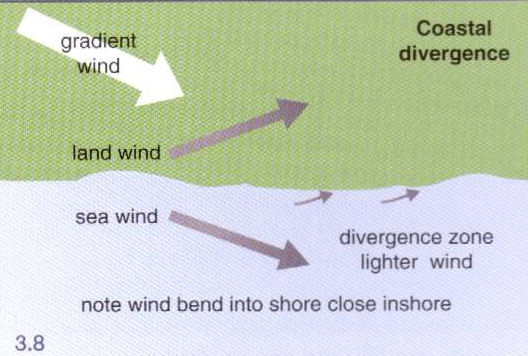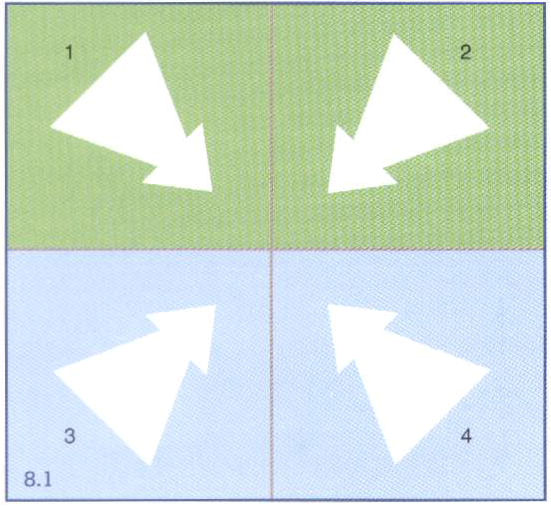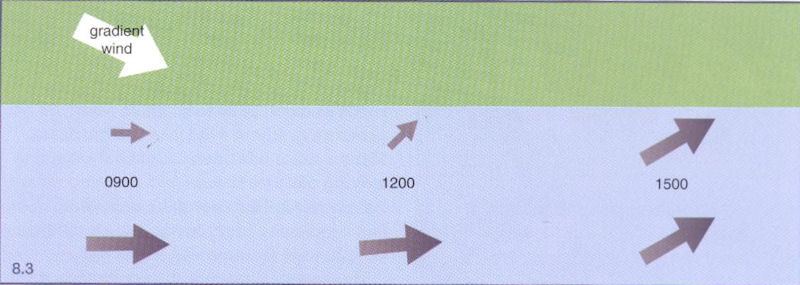
How to be a Sea Breeze Guru
by Steve Cockerill, Rooster Sailing 23 Apr 2010 15:17 BST
I can still remember arguing with a sailor on the beach at Lee on Solent that we would get a good sea breeze today - as the gradient was offshore in the Northwest quadrant. He was adamant that there was no chance of a sea breeze as it would fight the off shore wind. Later at about 12 o'clock we had a 'stonking' sea breeze; I just don't think he had even read Dave Hougton's 'Wind Strategy' now in its 4th Edition. It's got a fairly simple rule of thumb which makes you look like you have a 4th sense for the weather.

In the book David explains the conditions that encourage a sea breeze effects to start is one where you have coastal divergence, as shown in Fig 3.8 from 'Wind Strategy'. In the northern hemisphere with the gradient wind as shown, the wind will head over the land and vear over the sea as it obeys the coriolis rule. (stronger wind is more veered)
David then describes this wind as a quadrant 1 gradient wind which will develop a strong early sea breeze as long as the land is at least 5 degrees warmer than the sea - which is not difficult as the sea is at its relative coldest to the land during the day.

David Houghton's Quadrant Definitions from 'Wind Strategy'
With winds in quadrant 1, David describes the developing sea breeze with his figure 8.3

So sea breezes are more common in the spring than the Autumn, and when you are caught out on the water with what you think is a lovely warm spring day quickly becomes a chilly sea breeze with cold water spray to boot.
Often I see sailors wearing very little in these conditions, looking cool when leaving the shore and then wishing they had dressed a little more prepared once the Sea Breeze has come in. My answer to this conundrum of being cool before the sea breeze kicks in is the Rooster Thermaflex. It's ideal for hot shores and cold lakes - just what you experience this time of year all round the country. Tested and used by Navy Seals in the Mediterranean in 30 degrees. The Seals did a 5 mile run on the beach - and then went for a dive. They were amazed at the performance of the Lycra lining of the Super-stretch Neoprene which was able to keep them cool on the shore even on the 5 mile run and blown away by the warmth of the garment once they were in the water.
Check out the Thermaflex on line and see the reviews for yourself:
Thermaflex Top, 7.19.2008 Reviewer: mathew parsons (Penparc, Ceredigion)
this thing is bleeding fantastic!! i think i may have tested it today beond its initial design purpose. when you hit the water i think it is suposed to keep you warm while you are in the water whilst righting the boat. today however i was in the water much longer than that! it was very windy but very sunny too so i wore this top and an aquafleece. the idea was that the therma flex would keep me cool but the aquafleece would keep out the wind and stop me getting too cold. anyway the sail became a rescue situation so whilst my crew member went to the rescue i had to hold the boat in chest high water. (fortunatley we are cursed with a sand bank in the estuary) sometimes its handy sometimes its a pain. anyway the sand's irelevant to the top so i'll get back to it. so i had to stand in the water for a long time and to be fair it did indeed keep me warm, towards the end it did start to get a bit chilly but to be fair its very warm for its thickness. had i worn just an normal rash vest i'd have been very cold but also had i worn a hot top or something else desined for thermal insulation i would have overheated during dry sailing (well dry as in just damp from spray) which the aquafleece took care of. this top works well with the aquafleece as you have wind and spray protction and then the cooling effect of the top and the protection from the neoprene when you go swimming. i dont think it was made to go with the aquafleece but this is a typical british summer so they go together exelent. well done to the bright spark that made this top as its arguably the best idea out there!! is it worth the asking price? well ive never been so warm and cool at the same time! does that sound worth it?
Figures 3.8, 8.1 and 8.3 by kind permission of John Wiley and Sons Ltd.